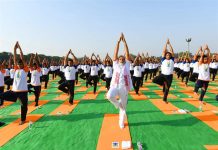 I guess you are just not what I want to see,” said the Professor to Ananya Chatterjea when she was in her Dance MA class at Columbia University which she had joined in 1989. “I was up against a particular white western aesthetic and my work just spelled trouble,” admits Chatterjea as I speak with her in the city she has called home for almost two decades now — Minneapolis. This continued into her doctoral studies at Temple University, where she created a choreographic piece around Draupadi’s multiple marriages. “It was not exotic enough, because it was not traditional, yet they objected to my using my face, and then, because I had questioned the claim of her choice and called it out to be marital rape, my Professor charged me with ‘using dance’ for different agendas,” recalled Chatterjea exasperatedly.
I guess you are just not what I want to see,” said the Professor to Ananya Chatterjea when she was in her Dance MA class at Columbia University which she had joined in 1989. “I was up against a particular white western aesthetic and my work just spelled trouble,” admits Chatterjea as I speak with her in the city she has called home for almost two decades now — Minneapolis. This continued into her doctoral studies at Temple University, where she created a choreographic piece around Draupadi’s multiple marriages. “It was not exotic enough, because it was not traditional, yet they objected to my using my face, and then, because I had questioned the claim of her choice and called it out to be marital rape, my Professor charged me with ‘using dance’ for different agendas,” recalled Chatterjea exasperatedly.
From those New York days when she was a part of the Asian American Dance Theatre in China Town, and was compelled to sneak in a contemporary choreography as an epilogue to her billed traditional dance performance, Chatterjea has come a long way. In July 2017, her Ananya Dance Theatre, a company of women dancers of colour with a few male dancers of colour now and then, won the National Dance Project grant that supports the creation and touring of new dance works across USA.
The second award that came to her in July, with links to both her academic work as well as her artistic efforts, was the Ada Comstock Distinguished Women Scholars Award presented by the University of Minnesota, where Chatterjea teaches, to honour the scholarly accomplishments of distinguished women faculty at the University, going to scholars from science and humanities in alternative years. The interesting aspect is that while all recipients this far have spoken about their scholarship, Chatterjea danced her acceptance at the award ceremony last fall. “I worked in a hybrid model of research and choreography, where choreography articulated the theoretical concerns at the heart of my work and scholarship was refined through the embodied knowing that came from the choreography.”
Breaking stereotypes is what Chatterjea has done all her life. For instance, after training in Odissi, which she learnt from Sanjukta Panigrahi, she was able to move away from the creating of beauty, which she described as “an easy beauty, seductive and plastic,” before clarifying, “I think that classical dance is beautiful, but in the current setting of capitalist markets, this is what it often becomes”.
She moved towards the creating of hard hitting social justice work. Actually, at one level, social justice work is not very different from the goals of classical dance, which is the savouring of rasa — the sentiment. A recent piece that ADT danced — ‘Just Breathe’ — to draw attention to how developmental decisions are always taken without care for the underprivileged- saw powerful choreography that within a run period of twenty minutes created a sledge hammer sentiment of disgust for inequitable policies. It was performed in the open with many distractions, but for those twenty minutes and more the audiences were riveted. This was an example of her social justice work and it spoke eloquently.
“What classical dance gives is an assurance of beauty. But we live in different times. Our access to beauty has to go through different routes of injustice, inequity and inequality.” She pursues social justice work in her choreographies, not like ‘nukkad nataks’ — street theatre, but “work, always with an eye to excellence”.
“We are in the business of creating a groundswell in the minds of our audiences, for only then can we shift mindsets. You can do that only with powerful work that cannot be dismissed. The pursuit of excellence is part of that striving,” explains Chatterjea. The website of ADT says clearly — “We radically reframe the ground on which we dance, inspiring our audiences through visual and emotional engagement”.
She credits her classical dance teachers in India “who were committed to a particular line and aesthetic, making sure that we delivered it each time, even if it meant that we practiced well past midnight even after a programme”.
The cogency of her dance comes from a new movement language that she has created to counter what she calls “the white aesthetic of contemporary dance”. Called Yorchha, a portmanteau word, it emerges from her training in Yoga, Odissi and Chhau. “I want a home for our bodies even as we deconstruct the technique. Yorchha allows me to be feminine and feminist, deconstructive and located. I come from Bengal that boasts of the seemingly contradictory concept of the Goddess as the Gentle warrior and the Dakini or vengeful feminine spirit from Tantra and Vajrayana Buddhism, and that is why you see so much upsidedown-ness, women’s intimacy, flying arms, open mouth, untamed hair, a severe rejection of established canons of beauty — but very powerful visual imagery — for our work is a treasure of feminist meaning making.” Explaining further about how her politics engage with her art, she says, “It is the interaction of Yorchha, our unique movement language, with Shawngram, our philosophy of resistance, which generates power”.
In Kolkata, where Chatterjea grew up, she danced classical and Tagore dances. With Hemango Biswas, IPTA’ s iconic song writer and theatre legend Shombhu Bhattacharji, young Ananya went from village to village in a rattletrap bus, carrying over long distances her costumes and kit, to perform in field clearings, as part of the Government’s interstate cultural programmes, enacting songs about class and feminist struggles. “By the time I came to this country I was already a feminist. Here I was to lose my Brahminical caste privilege. Quite definitely the seeds for my social justice work of today were laid in Kolkata,” reminisces Chatterjea.
She is clear about her concepts and philosophy. “I make a big distinction between social justice work and political work. Social justice work is an immersion in a process- in all stages of the process, from who is involved, how does the involvement play itself out, how the ideas are collected, how do we engage with the community whose stories we tell, where the fabric is coming from, what scenographic material is used, and how responsibly we carry respect for it all.” For instance, in one of her productions called ‘Morichhika’, created soon after she received the prestigious Guggenheim Fellowship for Choreography, about human greed with respect to the earth, she used “old rice, for a blinding storm, to show the devastation in the contamination of food sources. After every performance we would collect every grain and reuse it. At the end, we composted it”, described Ananya, testifying that treating the gifts of the earth responsibly is woven into the DNA of social justice activists.
In the series of works that her Company has produced every year, her inspiration has been global. From Nigerian activist Ken Saro-Wiwa, whose work in organizing the Ogoni people against the encroachment of Shell is legendary; from the thoughts of Vandana Shiva on seed sovereignty, to ‘River walker’ native American activist Sharon Day’s concerns about the sacredness of the waters of the rivers. Here is a dancer who defies the glamour and glories of the West and prefers to take her work to festivals in distant Ethiopia, Trinidad and Zimbabwe. “It’s our endeavour to inspire audiences everywhere to ‘Dak’— the call to action,” says Chatterjea, energetic and raring to go the many more miles of her mission.
letters@tehelka.com













